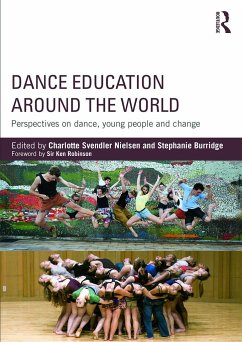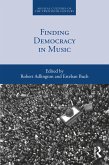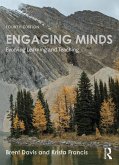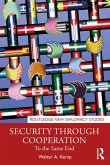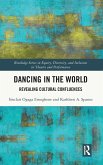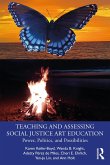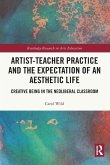Dance Education around the World
Perspectives on dance, young people and change
Herausgeber: Nielsen, Charlotte Svendler; Burridge, Stephanie
Dance Education around the World
Perspectives on dance, young people and change
Herausgeber: Nielsen, Charlotte Svendler; Burridge, Stephanie
- Broschiertes Buch
- Merkliste
- Auf die Merkliste
- Bewerten Bewerten
- Teilen
- Produkt teilen
- Produkterinnerung
- Produkterinnerung
This book brings together a collection of writers from across the globe to reflect, comment on and share their expertise and experiences in dance education, exploring issues and best practices for teaching and learning.
Andere Kunden interessierten sich auch für
![Finding Democracy in Music Finding Democracy in Music]() Finding Democracy in Music198,99 €
Finding Democracy in Music198,99 €![Engaging Minds Engaging Minds]() Brent DavisEngaging Minds56,99 €
Brent DavisEngaging Minds56,99 €![Security through Cooperation Security through Cooperation]() Walter A. Kemp (Global Initiative against Transnational Organized CSecurity through Cooperation58,99 €
Walter A. Kemp (Global Initiative against Transnational Organized CSecurity through Cooperation58,99 €![Dancing in the World Dancing in the World]() Sinclair Ogaga EmogheneDancing in the World198,99 €
Sinclair Ogaga EmogheneDancing in the World198,99 €![Rethinking Utopia Rethinking Utopia]() David M. BellRethinking Utopia69,99 €
David M. BellRethinking Utopia69,99 €![Teaching and Assessing Social Justice Art Education Teaching and Assessing Social Justice Art Education]() Karen Keifer-Boyd (USA The Pennsylvania State University)Teaching and Assessing Social Justice Art Education61,99 €
Karen Keifer-Boyd (USA The Pennsylvania State University)Teaching and Assessing Social Justice Art Education61,99 €![Artist-Teacher Practice and the Expectation of an Aesthetic Life Artist-Teacher Practice and the Expectation of an Aesthetic Life]() Carol Wild (UK University of Warwick)Artist-Teacher Practice and the Expectation of an Aesthetic Life62,99 €
Carol Wild (UK University of Warwick)Artist-Teacher Practice and the Expectation of an Aesthetic Life62,99 €-
-
-
This book brings together a collection of writers from across the globe to reflect, comment on and share their expertise and experiences in dance education, exploring issues and best practices for teaching and learning.
Hinweis: Dieser Artikel kann nur an eine deutsche Lieferadresse ausgeliefert werden.
Hinweis: Dieser Artikel kann nur an eine deutsche Lieferadresse ausgeliefert werden.
Produktdetails
- Produktdetails
- Verlag: Taylor & Francis Ltd
- Seitenzahl: 208
- Erscheinungstermin: 13. April 2015
- Englisch
- Abmessung: 246mm x 174mm x 11mm
- Gewicht: 382g
- ISBN-13: 9780415743631
- ISBN-10: 041574363X
- Artikelnr.: 41847100
- Herstellerkennzeichnung
- Libri GmbH
- Europaallee 1
- 36244 Bad Hersfeld
- gpsr@libri.de
- Verlag: Taylor & Francis Ltd
- Seitenzahl: 208
- Erscheinungstermin: 13. April 2015
- Englisch
- Abmessung: 246mm x 174mm x 11mm
- Gewicht: 382g
- ISBN-13: 9780415743631
- ISBN-10: 041574363X
- Artikelnr.: 41847100
- Herstellerkennzeichnung
- Libri GmbH
- Europaallee 1
- 36244 Bad Hersfeld
- gpsr@libri.de
Charlotte Svendler Nielsen is Assistant Professor and Head of educational studies at the Department of Nutrition, Exercise and Sports, research group Body, Learning and Identity, University of Copenhagen, Denmark. Stephanie Burridge lectures at Lasalle College of the Arts and Singapore Management University, and is the series editor for Routledge Celebrating Dance in Asia and the Pacific.
Foreword Sir Ken Robinson Part 1: Curriculum Development Worldwide 1.1
Applied Dance Curriculum: A global perspective Susan Koff 1.2 An Australian
Dance Curriculum for Social Justice: Potentials and possibilities Jeff
Meiners and Robyne Garrett 1.3 Reciprocal Engagement in Dance: Empowering
encounters in New Zealand early childhood settings Adrienne Sansom
1.4 From Concept to Classroom: Challenges facing the implementation of the
dance curriculum in the Western Cape of South Africa Sharon Friedman 1.5
Dance in the New Zealand Classroom: Making connections Liz Melchior 1.6
Creative Dance Education in a Singapore Primary School Lim Mei Chian Part
2: Empowering Communities through Dance 2.1 Exploring the rights of the
First Nations child through the arts: Our dreams matter too Mary-Elizabeth
Manley 2.2 Dancing Beyond the Post-Trauma Paradigm: Community projects in
the Occupied Palestinian Territories Nicholas Rowe 2.3 The Politics of
Dance Education in Post-Revolutionary Cairo Rosemary Martin 2.4 Traditional
Dance in Ghanaian Schools: Maintaining national identity through the
involvement of youth and children Beatrice Ayi 2.5 Negotiating Multiple
Spheres of Identity: A Filipino community in Toronto, Canada Catherine
Limbertie Part 3: Embodiment and Creativity in Dance Teaching 3.1 Dance as
Embodied Dialogue: Insights from a school project in Finland Eeva Anttila
3.2 Transformative Impact of Dance Experiences in Brazil Alba Vieira 3.3
Dialogue and 'Pedagogical Love': Atmosphere and reflexivity in dance Isto
Turpeinen 3.4 Teaching for Better Lives: The philosophy of a Jamaican dance
teacher Carolyn Russell-Smith 3.5 "The Summer Workshop of Dance Education
for Children" at Tainan University of Technology, Taiwan JuanAnn Tai Part
4: Exploring and Assessment in Dance Education 4.1 Rethinking Standards and
Assessment in Dance Education Susan W. Stinson 4.2 Exploring Learning in
Dance as Artistic-Educational Practice Charlotte Svendler Nielsen 4.3
Stepping into Skin: Expanding empathy through dance Kristen Jeppsen Groves
and Marin Leggat Roper 4.4 Making the Learning Visible in Creative Dance
Education Marc Richard 4.5 Watching Dance in Order to Discover 'New Worlds'
Liesbeth Wildschut Part 5: Imagined Futures for Dance Education 5.1 Dance
Education: Embodied knowing in the digitalized world Ann Kipling-Brown 5.2
Partnerships for Creativity: Expanding teaching possibilities Kerry
Chappell and Veronica Jobbins 5.3 Stepping Back to Step Forward:
Reflections on future directions for dance education Ralph Buck 5.4
Twinning: An intercultural approach in dance education Maria Speth 5.5 The
Post Natyam Collective: Building grassroots artistic community online
Cynthia Ling Lee
Applied Dance Curriculum: A global perspective Susan Koff 1.2 An Australian
Dance Curriculum for Social Justice: Potentials and possibilities Jeff
Meiners and Robyne Garrett 1.3 Reciprocal Engagement in Dance: Empowering
encounters in New Zealand early childhood settings Adrienne Sansom
1.4 From Concept to Classroom: Challenges facing the implementation of the
dance curriculum in the Western Cape of South Africa Sharon Friedman 1.5
Dance in the New Zealand Classroom: Making connections Liz Melchior 1.6
Creative Dance Education in a Singapore Primary School Lim Mei Chian Part
2: Empowering Communities through Dance 2.1 Exploring the rights of the
First Nations child through the arts: Our dreams matter too Mary-Elizabeth
Manley 2.2 Dancing Beyond the Post-Trauma Paradigm: Community projects in
the Occupied Palestinian Territories Nicholas Rowe 2.3 The Politics of
Dance Education in Post-Revolutionary Cairo Rosemary Martin 2.4 Traditional
Dance in Ghanaian Schools: Maintaining national identity through the
involvement of youth and children Beatrice Ayi 2.5 Negotiating Multiple
Spheres of Identity: A Filipino community in Toronto, Canada Catherine
Limbertie Part 3: Embodiment and Creativity in Dance Teaching 3.1 Dance as
Embodied Dialogue: Insights from a school project in Finland Eeva Anttila
3.2 Transformative Impact of Dance Experiences in Brazil Alba Vieira 3.3
Dialogue and 'Pedagogical Love': Atmosphere and reflexivity in dance Isto
Turpeinen 3.4 Teaching for Better Lives: The philosophy of a Jamaican dance
teacher Carolyn Russell-Smith 3.5 "The Summer Workshop of Dance Education
for Children" at Tainan University of Technology, Taiwan JuanAnn Tai Part
4: Exploring and Assessment in Dance Education 4.1 Rethinking Standards and
Assessment in Dance Education Susan W. Stinson 4.2 Exploring Learning in
Dance as Artistic-Educational Practice Charlotte Svendler Nielsen 4.3
Stepping into Skin: Expanding empathy through dance Kristen Jeppsen Groves
and Marin Leggat Roper 4.4 Making the Learning Visible in Creative Dance
Education Marc Richard 4.5 Watching Dance in Order to Discover 'New Worlds'
Liesbeth Wildschut Part 5: Imagined Futures for Dance Education 5.1 Dance
Education: Embodied knowing in the digitalized world Ann Kipling-Brown 5.2
Partnerships for Creativity: Expanding teaching possibilities Kerry
Chappell and Veronica Jobbins 5.3 Stepping Back to Step Forward:
Reflections on future directions for dance education Ralph Buck 5.4
Twinning: An intercultural approach in dance education Maria Speth 5.5 The
Post Natyam Collective: Building grassroots artistic community online
Cynthia Ling Lee
Foreword Sir Ken Robinson Part 1: Curriculum Development Worldwide 1.1
Applied Dance Curriculum: A global perspective Susan Koff 1.2 An Australian
Dance Curriculum for Social Justice: Potentials and possibilities Jeff
Meiners and Robyne Garrett 1.3 Reciprocal Engagement in Dance: Empowering
encounters in New Zealand early childhood settings Adrienne Sansom
1.4 From Concept to Classroom: Challenges facing the implementation of the
dance curriculum in the Western Cape of South Africa Sharon Friedman 1.5
Dance in the New Zealand Classroom: Making connections Liz Melchior 1.6
Creative Dance Education in a Singapore Primary School Lim Mei Chian Part
2: Empowering Communities through Dance 2.1 Exploring the rights of the
First Nations child through the arts: Our dreams matter too Mary-Elizabeth
Manley 2.2 Dancing Beyond the Post-Trauma Paradigm: Community projects in
the Occupied Palestinian Territories Nicholas Rowe 2.3 The Politics of
Dance Education in Post-Revolutionary Cairo Rosemary Martin 2.4 Traditional
Dance in Ghanaian Schools: Maintaining national identity through the
involvement of youth and children Beatrice Ayi 2.5 Negotiating Multiple
Spheres of Identity: A Filipino community in Toronto, Canada Catherine
Limbertie Part 3: Embodiment and Creativity in Dance Teaching 3.1 Dance as
Embodied Dialogue: Insights from a school project in Finland Eeva Anttila
3.2 Transformative Impact of Dance Experiences in Brazil Alba Vieira 3.3
Dialogue and 'Pedagogical Love': Atmosphere and reflexivity in dance Isto
Turpeinen 3.4 Teaching for Better Lives: The philosophy of a Jamaican dance
teacher Carolyn Russell-Smith 3.5 "The Summer Workshop of Dance Education
for Children" at Tainan University of Technology, Taiwan JuanAnn Tai Part
4: Exploring and Assessment in Dance Education 4.1 Rethinking Standards and
Assessment in Dance Education Susan W. Stinson 4.2 Exploring Learning in
Dance as Artistic-Educational Practice Charlotte Svendler Nielsen 4.3
Stepping into Skin: Expanding empathy through dance Kristen Jeppsen Groves
and Marin Leggat Roper 4.4 Making the Learning Visible in Creative Dance
Education Marc Richard 4.5 Watching Dance in Order to Discover 'New Worlds'
Liesbeth Wildschut Part 5: Imagined Futures for Dance Education 5.1 Dance
Education: Embodied knowing in the digitalized world Ann Kipling-Brown 5.2
Partnerships for Creativity: Expanding teaching possibilities Kerry
Chappell and Veronica Jobbins 5.3 Stepping Back to Step Forward:
Reflections on future directions for dance education Ralph Buck 5.4
Twinning: An intercultural approach in dance education Maria Speth 5.5 The
Post Natyam Collective: Building grassroots artistic community online
Cynthia Ling Lee
Applied Dance Curriculum: A global perspective Susan Koff 1.2 An Australian
Dance Curriculum for Social Justice: Potentials and possibilities Jeff
Meiners and Robyne Garrett 1.3 Reciprocal Engagement in Dance: Empowering
encounters in New Zealand early childhood settings Adrienne Sansom
1.4 From Concept to Classroom: Challenges facing the implementation of the
dance curriculum in the Western Cape of South Africa Sharon Friedman 1.5
Dance in the New Zealand Classroom: Making connections Liz Melchior 1.6
Creative Dance Education in a Singapore Primary School Lim Mei Chian Part
2: Empowering Communities through Dance 2.1 Exploring the rights of the
First Nations child through the arts: Our dreams matter too Mary-Elizabeth
Manley 2.2 Dancing Beyond the Post-Trauma Paradigm: Community projects in
the Occupied Palestinian Territories Nicholas Rowe 2.3 The Politics of
Dance Education in Post-Revolutionary Cairo Rosemary Martin 2.4 Traditional
Dance in Ghanaian Schools: Maintaining national identity through the
involvement of youth and children Beatrice Ayi 2.5 Negotiating Multiple
Spheres of Identity: A Filipino community in Toronto, Canada Catherine
Limbertie Part 3: Embodiment and Creativity in Dance Teaching 3.1 Dance as
Embodied Dialogue: Insights from a school project in Finland Eeva Anttila
3.2 Transformative Impact of Dance Experiences in Brazil Alba Vieira 3.3
Dialogue and 'Pedagogical Love': Atmosphere and reflexivity in dance Isto
Turpeinen 3.4 Teaching for Better Lives: The philosophy of a Jamaican dance
teacher Carolyn Russell-Smith 3.5 "The Summer Workshop of Dance Education
for Children" at Tainan University of Technology, Taiwan JuanAnn Tai Part
4: Exploring and Assessment in Dance Education 4.1 Rethinking Standards and
Assessment in Dance Education Susan W. Stinson 4.2 Exploring Learning in
Dance as Artistic-Educational Practice Charlotte Svendler Nielsen 4.3
Stepping into Skin: Expanding empathy through dance Kristen Jeppsen Groves
and Marin Leggat Roper 4.4 Making the Learning Visible in Creative Dance
Education Marc Richard 4.5 Watching Dance in Order to Discover 'New Worlds'
Liesbeth Wildschut Part 5: Imagined Futures for Dance Education 5.1 Dance
Education: Embodied knowing in the digitalized world Ann Kipling-Brown 5.2
Partnerships for Creativity: Expanding teaching possibilities Kerry
Chappell and Veronica Jobbins 5.3 Stepping Back to Step Forward:
Reflections on future directions for dance education Ralph Buck 5.4
Twinning: An intercultural approach in dance education Maria Speth 5.5 The
Post Natyam Collective: Building grassroots artistic community online
Cynthia Ling Lee

